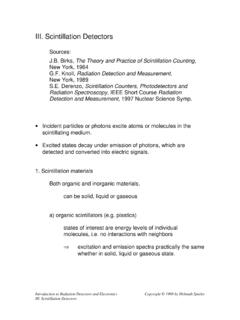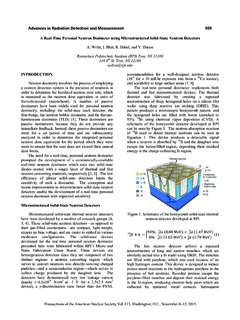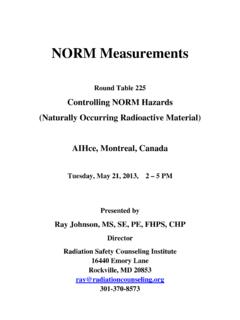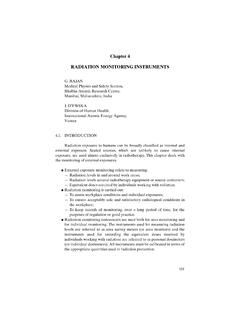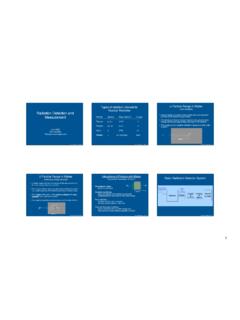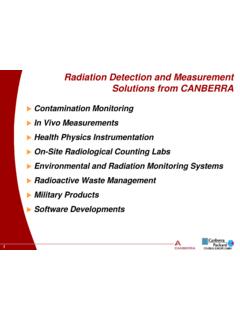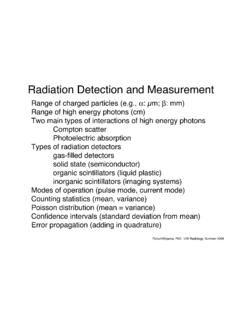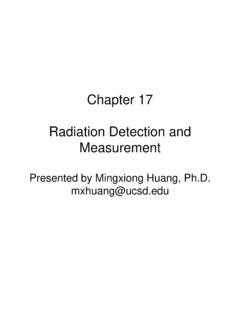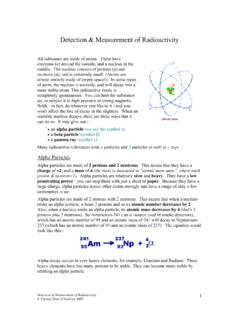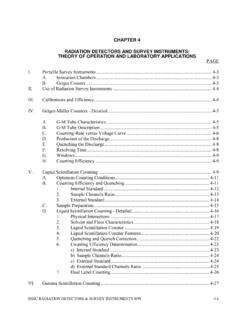Transcription of Radiation Detection and Measurement
1 IEEE NPSS Short CourseRadiation Detection and MeasurementNovember 10 11, 20022002 Nuclear Science SymposiumNorfolk, VirginiaPulse Processing and AnalysisHelmuth SpielerPhysics DivisionLawrence Berkeley National LaboratoryBerkeley, CA 94720 These course notes and additional tutorials ~spieler2002 IEEE Short Course Radiation Detection and MeasurementHelmuth SpielerPulse Processing and AnalysisLBNL2 Table of Contents1. Overview2. Acquiring the Detector Signal3. Resolution and Signal-to-Noise RatioPulse ShapingEquivalent Noise ChargeSources of Electronic Noise4. Some Other Aspects of Pulse Shaping5. Timing Measurements6. Digitization of Pulse and Time- Analog to Digital Conversion7.
2 Digital Signal Processing8. Why Things Don t Work9. Summary of Considerations in Detector Electronics2002 IEEE Short Course Radiation Detection and MeasurementHelmuth SpielerPulse Processing and AnalysisLBNL31. OverviewPurpose of pulse processing and analysis systems:1. acquire electrical signal from detectortypically a short current pulse2. tailor the time response ( shape the output pulse) of the system to optimize minimum detectable signal energy Measurement (magnitude of signal) event rate time of arrival (timing Measurement ) insensitivity to detector pulse shape some combination of the above Generally, these cannot be optimized simultaneously compromises3.
3 Digitize the signal and store for subsequent analysisAdditional requirements, depending on specific application, resistancelow powerportable systems large detector arrays, in HEProbustnesscost2002 IEEE Short Course Radiation Detection and MeasurementHelmuth SpielerPulse Processing and AnalysisLBNL4A Typical Detector System Scintillation DetectorProcesses in Scintillator Photomultipliernumber of photonsnumber of photoelectrons charge in pulse absorbed energy absorbed energy abs. energySignal Processingcharge in pulsepulse height abs. energy absorbed energySCINTILLATORPHOTOMULTIPLIERCURRENT PULSEINCIDENT RADIATIONINCIDENT RADIATIONSCINTILLATORPHOTOCATHODEELECTRO NMULTIPLIERLIGHTELECTRONSELECTRICALSIGNA LPHOTOMULTIPLIERPULSE SHAPINGANALOG TO DIGITAL CONVERSIONDIGITALDATA BUS2002 IEEE Short Course Radiation Detection and MeasurementHelmuth SpielerPulse Processing and AnalysisLBNL5 Ionization ChamberAll ionization chambers utilize the same principle:1.
4 Particles deposit energy in an absorber and create mobilecharge carriers (positive and negative charge pairs).in solids, liquids:electrons and holesin gases:electrons and ions2. Electric field applied to detector volume sweeps chargecarriers towards electrodes and induces a signal currentvelocity of charge carriersrate of induced charge ondetector electrodessignal chargeif Ri x (Cdet + Ci) >> collection time tc:peak voltage at amplifier inputissCCQV+=detRAMPLIFIERVinDETECTORCC idetivqtdqQscsstttdt2002 IEEE Short Course Radiation Detection and MeasurementHelmuth SpielerPulse Processing and AnalysisLBNL6 The SignalAny form of elementary excitation can be used to detect the energyMagnitude of signalexcitation energy=An electrical signal can be formed directly by Radiation quanta impart sufficient energy to individualatomic electrons to form electron-ion pairs (in gases) orelectron-hole pairs (in semiconductors and metals).
5 Other Detection mechanisms areExcitation of optical states (scintillators) light intensityExcitation of lattice vibrations (phonons) temperatureBreakup of Cooper pairs in superconductorsFormation of superheated droplets in superfluid HeTypical excitation energiesIonization in gases~30 eVIonization in semiconductors1 10 eVScintillation20 - 500 eVPhononsmeVBreakup of Cooper PairsmeV2002 IEEE Short Course Radiation Detection and MeasurementHelmuth SpielerPulse Processing and AnalysisLBNL7 Precision of signal magnitude is limited by fluctuationsTwo types of fluctuations1. Fluctuations in signal charge for a given energy absorption indetectorsignal formed by many elementary excitationsabsorbed energynumber of signal quantaexcitation energyiENE==Number of signal quanta fluctuates =where F is the Fano factor ( in Si, for example),so the energy resolution = = = 2.
6 Baseline fluctuations in the electronics electronic noise The overall resolution is often the result of several resolutions add in quadrature, for example22flucelecEEE = + If one contribution is 20% of the other, the overall resolution isincreased by 10%.2002 IEEE Short Course Radiation Detection and MeasurementHelmuth SpielerPulse Processing and AnalysisLBNL8 Resolution of NaI(Tl) and Ge detectors( Philippot, IEEE Trans. Nucl. Sci. NS-17/3 (1970) 446)NaI(Tl) scintillation detector:signal fluctuationsGe detector:predominantly electronic noise2002 IEEE Short Course Radiation Detection and MeasurementHelmuth SpielerPulse Processing and AnalysisLBNL9 Resolution increases sensitivitySignal to background ratio improves with better resolution(narrow peak competes with fewer background counts) Armantrout, et al.
7 , IEEE Trans. Nucl. Sci. NS-19/1 (1972) 1072002 IEEE Short Course Radiation Detection and MeasurementHelmuth SpielerPulse Processing and AnalysisLBNL10 Signal Fluctuations in a Scintillation DetectorExample: a typical NaI(Tl) system (from Derenzo)511 keV gamma ray 25000 photons in scintillator 15000 photons at photocathode 3000 photoelectrons at first dynode electrons at anode2 mA peak currentResolution of energy Measurement determined by statistical varianceof produced signal determined by smallest number of quanta in chain, of photoelectrons arriving at first this exampleTypically 7 8% obtained, due to non-uniformity of light collectionand gain.
8 EENNNNN===1 EE==13000 2% = 5% FWHM2002 IEEE Short Course Radiation Detection and MeasurementHelmuth SpielerPulse Processing and AnalysisLBNL11 Baseline Fluctuations (Electronic Noise)Choose a time when no signal is s quiescentoutput level (baseline):sensitivity x10 These fluctuations areadded to any inputsignalPulse output of theideal system(sensitivity x1)Signal + NoiseMeasurement of peak amplitude yieldssignal amplitude + noise fluctuationTIMETIMETIME2002 IEEE Short Course Radiation Detection and MeasurementHelmuth SpielerPulse Processing and AnalysisLBNL12 The preceding example could imply that the fluctuations tend toincrease the measured amplitude, since the noise fluctuationsvary more rapidly than the an optimized system, the time scale of the fluctuation iscomparable to the signal peaking the measured amplitude fluctuates positive and negativerelative to the ideal taken at 4 different times.
9 (noiseless signal superimposed for comparison)Amplitude distribution of noise appears as amplitudedistribution of IEEE Short Course Radiation Detection and MeasurementHelmuth SpielerPulse Processing and AnalysisLBNL133. The ProblemRadiation impinges on a sensor and creates an electrical signal level is low and must be amplified to allow digitization the sensor and amplifiers introduce signal fluctuations Fluctuations in signal introduced by sensor2. Noise from electronics superimposed on signalThe Detection limit and Measurement accuracy are determined by thesignal-to-noise noise affects all measurements:1. Detect presence of hit:Noise level determines minimum threshold too low, output dominated by noise Energy Measurement :noise smears signal amplitude3.
10 Time measurementnoise alters time dependence of signal pulseHow to optimize the signal-to-noise ratio?1. Increase signal and reduce noise2. For a given sensor and signal: reduce electronic noise2002 IEEE Short Course Radiation Detection and MeasurementHelmuth SpielerPulse Processing and AnalysisLBNL14 Assume that the signal is a time distribution of the signal corresponds to afrequency spectrum (Fourier transform).Examples: Time Domain Frequency DomainThe pulse is unipolar, so it has a DC component and thefrequency spectrum extends down to bipolar pulse carries no net charge, so the frequencyspectrum falls to zero at low + + + + +08 [radians]A( ) + [s]A(t) + + + + +08 [radians]A( ) + [s]A(t)2002 IEEE Short Course Radiation Detection and MeasurementHelmuth SpielerPulse Processing and AnalysisLBNL15 The noise spectrum generally not the same as the Noise Spectrum.

